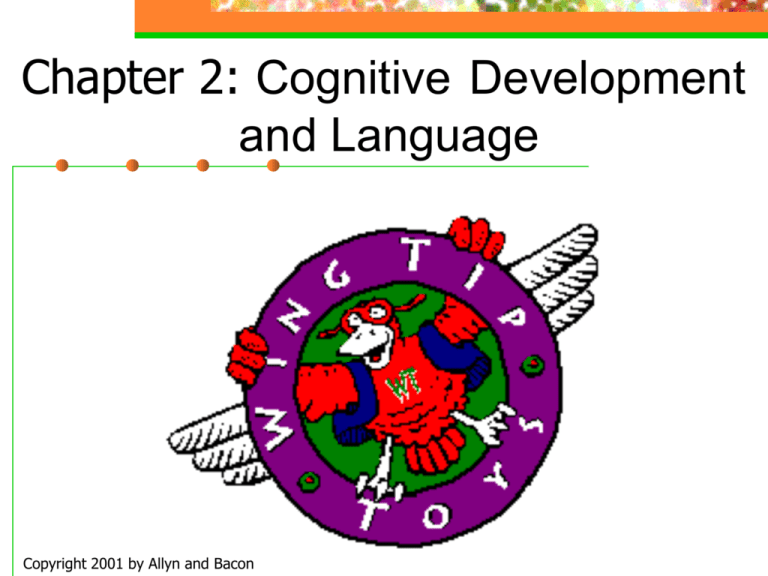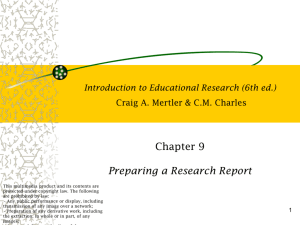Human Development
advertisement

Chapter 2: Cognitive Development and Language Copyright 2001 by Allyn and Bacon Overview Definition of Development Piaget’s Theory of Cognitive Development Implications of Piaget’s Theory Vygotsky Sociocultural Perspective Implications of Vygotsky’s Theory Development of Language Copyright 2001 by Allyn and Bacon Concept Map for Chapter 2 Language Development Development Defined Cognitive Development and Language Vygotsky’s Theory and Implications Copyright 2001 by Allyn and Bacon Piaget’s Theory and Implications Development Copyright 2001 by Allyn and Bacon Types of Developmental Change Physical Personal Social Cognitive Copyright 2001 by Allyn and Bacon Principles of Development Rates differ Orderly Gradual Copyright 2001 by Allyn and Bacon Brain Development Main structures Specialization and integration Lateralization Storing and transferring information Copyright 2001 by Allyn and Bacon Jean Piaget Copyright 2001 by Allyn and Bacon Piaget’s Theory of Cognitive Development Maturation Activity Social transmission Equilibration Mnemonic: MASE Copyright 2001 by Allyn and Bacon Piagetian Terminology Organization Schemes / schema Adaptation Assimilation Accommodation Equilibration Equilibrium Disequilibrium Copyright 2001 by Allyn and Bacon Piaget’s Stages of Cognitive Development Sensorimotor Pre-operational Concrete operations Formal operations Copyright 2001 by Allyn and Bacon Sensorimotor Stage: 0-2 Learning through 5 senses Object permanence Goal directed actions Copyright 2001 by Allyn and Bacon Rules for Toddlers If I like it, it’s mine. If it’s in my hand, it’s mine. If I can take it from you, it’s mine. If I had it a little while ago, it’s mine. If it’s mine, it must never appear to be yours in any way. Copyright 2001 by Allyn and Bacon Rules for Toddlers, continued If I’m doing or building something, all the pieces are mine. If it looks like mine, it’s mine. If I saw it first, it’s mine. If you are playing with something, and you put it down, it automatically becomes mine. If it’s broken, it’s yours! Copyright 2001 by Allyn and Bacon Preoperational Stage: 2-7 Operations Semiotic function One-way logic Difficulty with centering & conservation Egocentrism Language develops Copyright 2001 by Allyn and Bacon Concrete Operational Stage: Ages 7 - 11 ‘Hands on’ thinking Conservation, identity, compensation Reversability Classification Seriation Copyright 2001 by Allyn and Bacon Formal Operational Stage: Ages 11 - 15 Not all individuals reach this stage Hypotheticodeductive reasoning ‘Scientific’ reasoning Adolescent egocentrism & imaginary audience Copyright 2001 by Allyn and Bacon Implications of Piaget’s Theory for Teachers Understanding students’ thinking ‘Match’ teaching to cognitive stage Presentation strategies Illustrations and examples Assignments Use disequilibrium to motivate Individuals ‘construct’ knowledge Use disequilibrium to motivate See Guidelines, Woolfolk pp. 33, 36, & 38 Copyright 2001 by Allyn and Bacon Create a Mnemonic for Piaget’s Four Stages Examples: Sometimes Piaget Can Frustrate! Sophomore Psychologists Can’t Fail! Copyright 2001 by Allyn and Bacon Limitations of Piaget Stage theory inconsistencies Underestimating children's abilities Cognitive development & information processing Overlooks influence of cultural and social groups See Point▼Counterpoint, Woolfolk p. 41 Copyright 2001 by Allyn and Bacon Lev Vygotsky Copyright 2001 by Allyn and Bacon Vygotsky Sociocultural Perspective Knowledge is co-constructed Interpsychological Intrapsychological Social interactions Role of cultural tools Role of language & private speech Self-talk & learning Role of adults and peers Copyright 2001 by Allyn and Bacon Private Speech: Piaget versus Vygotsky Piaget Developmental Lack of ability Significance Course of Declines with Development age Relationship to Social Speech Relationship to Environmental Context Copyright 2001 by Allyn and Bacon Negative; immature Piaget did not comment Vygotsky External thinking Increases in youth, then declines Positive; social stimulated Increases with task difficulty Implications of Vygotsky’s Theory for Teachers Copyright 2001 by Allyn and Bacon Assisted learning Scaffolding Zone of proximal development Collaborative learning Alternative assessment See Table p. 50 & Guidelines p. 52 Reflection Questions Compare Piaget with Vygotsky regarding implications for teaching. Compare disequilibrium with the zone of proximal development. Compare the role of social transmission in Piaget’s and Vygotsky’s theories. Copyright 2001 by Allyn and Bacon Language Development Copyright 2001 by Allyn and Bacon Language Development Reinforced behaviors or special capacity for language learning? Influences of heredity and environment Copyright 2001 by Allyn and Bacon Language Development: The School Years Pronunciation Syntax Vocabulary & meaning Metalinguistic awareness Copyright 2001 by Allyn and Bacon st 1 Grade Teachers and Literacy Build on existing emerging literacy skills Be supportive and positive Actively involve children in meaningful, functional language experiences Acknowledge differences Emphasize reading Develop partnerships with families See Family and Community Partnerships, Woolfolk, p. 56 Copyright 2001 by Allyn and Bacon Summary Definition of Development Piaget’s Theory of Cognitive Development Implications of Piaget’s Theory Vygotsky Sociocultural Perspective Implications of Vygotsky’s Theory Development of Language Copyright 2001 by Allyn and Bacon Review Questions What are three principles of development? What part of the brain is associated with higher mental functions? What is lateralization and why is it important? What are the main influences on cognitive development? What is a scheme? Copyright 2001 by Allyn and Bacon Review Questions As children move through Piaget’s four stages, what are the major changes? What is the “problem of the match”? What is active learning? Why is Piaget’s theory consistent with active learning? What are some limitations of Piaget’s theory? Explain how interpsychological development becomes intrapsychological development. Copyright 2001 by Allyn and Bacon Review Questions What are the differences between Piaget’s and Vygotsky’s view of private speech and its role in development? What is assisted learning? Scaffolding? What is a student’s zone of proximal development? How are humans predisposed to develop language? What role does learning play? Describe teacher actions and responses that encourage language development. Copyright 2001 by Allyn and Bacon Compare & Contrast Piaget’s and Vygotsky’s Theories. Piaget Key concepts Role of teacher Can development be accelerated? How does the child’s thinking change with age? How does social interaction affect cognitive level? Copyright 20012001 by Allyn Bacon Copyright by and Allyn and Bacon Vygotsky Short Answer When a child can focus on both width and length of two triangles in order to compare their areas, Piaget would say that the child is capable of _________________. Copyright 2001 by Allyn and Bacon Short Answer When a child can focus on both width and length of two triangles in order to compare their areas, Piaget would say that the child is capable of decentering. Copyright 2001 by Allyn and Bacon Multiple Choice According to Vygotsky, which of the following would be most influential on a child’s learning? a. Social transmission b. Cognitive level c. Repetition of information d. Maturation Copyright 2001 by Allyn and Bacon Multiple Choice According to Vygotsky, which of the following would be most influential on a child’s learning? a. Social transmission b. Cognitive level c. Repetition of information d. Maturation Copyright 2001 by Allyn and Bacon Mnemonics: How Will You Remember…... Copyright 2001 by Allyn and Bacon Piaget’s influences on development? Piaget’s four stages? The zone of proximal development? End Chapter 2 Copyright 2001 by Allyn and Bacon




